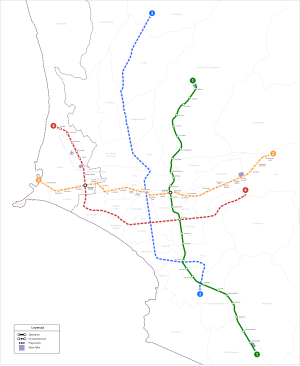Lima Metro
The Lima Metro (Spanish: Metro de Lima) is a rapid transit system operated by Argentinian company Ferrovías and Peruvian company Graña y Montero,[3] currently linking the district of Villa El Salvador in the south of Lima with San Juan de Lurigancho in the northeast of the capital of Peru.
.svg.png) | |||
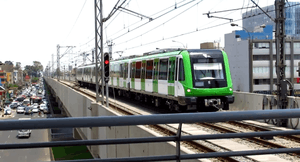 Alstom Metropolis 9000 on the Line 1 (2013) | |||
| Overview | |||
|---|---|---|---|
| Native name | Metro de Lima | ||
| Locale | Lima, Peru | ||
| Transit type | Rapid transit | ||
| Number of lines | 1 | ||
| Number of stations | 26 | ||
| Daily ridership | 692,000 per day[1] | ||
| Annual ridership | 124,134,820 [2] | ||
| Operation | |||
| Began operation | April 28, 1990 (completion) July 11, 2011 (revenue service) | ||
| Operator(s) | Ferrovías (Grupo Emepa) | ||
| Technical | |||
| System length | 34.6 km (21.5 mi) | ||
| Track gauge | 1,435 mm (4 ft 8 1⁄2 in) standard gauge | ||
| Electrification | overhead lines | ||
| |||
Despite the line having obtained 32 cars and completed construction of 7 stations for over many years, it did not operate a commercial service in 1990 during the first presidency of Alan García (1985–1990) because the constructed section didn't have the distance or demand required to make it commercially viable. The construction of the Lima Metro remained paralyzed since that time under accusations of bribes, after an investment of 226 million dollars co-financed by the Italian government.
Thus, the Peruvian Government under the second presidency of Alan García (2006–2011) put the Ministry of Transport and Communications in charge of completing Line 1, extending its current tracks up to Av. Grau in the city center, making a total of 34.6 kilometers (21.5 mi) of elevated viaduct with 26 stations and crossing several districts: Villa El Salvador, Villa María del Triunfo, San Juan de Miraflores, Santiago de Surco, Surquillo, San Borja, San Luis, La Victoria, Lima District and San Juan de Lurigancho. Line 1 finally opened for revenue service on July 11, 2011. At 35 km (22 mi) long, Metro Line 1 is the longest in the Americas, and the elevated viaduct of Metro railway was the longest in the world until it was surpassed by Wuhan Metro Line 1 in 2017.[4]
History
Beginning
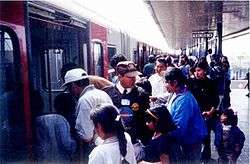
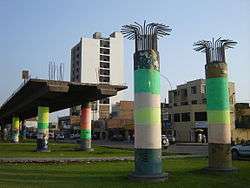
Between 1972 and 1973, the "Metrolima" consortium elaborated the technical-economical feasibility studies and the pre-project of the "Mass Rapid Transit System for Passengers in the Metropolitan Area of Lima and Callao", approved by the Government of Peru in 1974. However, the political crisis generated by the sudden illness of President Juan Velasco Alvarado and the problem of his succession, added to the complexity of the Limean soil located in a highly seismic zone, as well as the international economic crisis of the time, made it impossible to get the necessary financing of US$317,000,000. This way, the "Metrolima" project, contemplating a total of 5 lines of underground train, was unable to be realized.
In 1986, the first presidency of Alan García created the "Autonomous Authority for the Mass Transit Electrical Transport System Special Project" with the Supreme Decree N° 001-86 MIPRE, with degree of Law N° 24565. This entity called for a public contest for the implementation of this system, won by the Italian-capital "Consorcio Tralima" consortium. It started promptly the infrastructure work for an elevated viaduct metro.
Construction started by placing the first stone on October 18, 1986, making its construction the main promise made in 1987 by the newly elected Mayor of Lima and member of the government party Jorge del Castillo.
The work began with a maintenance facility in the district of Villa El Salvador, south of the city, where the trains were meant to be stored and receive preventive maintenance. Construction advanced at a relatively fast pace, but when Line 1 reached the Atocongo Station the country was immersed in a deep economical and social crisis, which halted construction. It was meant to continue through Av. Aviación up to the Dos de Mayo Hospital in the city center, but the assigned budget had been already spent.
In April 28, 1990, three months before ending the first government by APRA, Alan García celebrated the opening of the line, despite the fact that the line was incomplete and did not reach areas of higher demand and density. The metro remained nearly useless in practice, given that the required investments for its operation and maintenance were unjustifiable for its ridership. In spite of that, the subsequent governments tried to revive the project because of the significant investment put into the trains and infrastructure. On several occasions, candidates in both presidential and municipal elections used it politically with the promise of finishing the project, although it never materialized.
The municipalities crossed by the metro started to cover the unfinished segments in an attempt to diminish the negative impact on the urban landscape. This way, the centre median of Av. Aviación had pillars with grass in order to avoid the invasion of ambulatory commerce (which represented a large problem in Lima at the time). Vegetation was planted in order to cover the uncovered pieces of steel and concrete of the unfinished project. Some districts also painted the columns and walls with images of Peruvian landscapes and nature, deeming the project as definitively cancelled.
On August 5, 2001, the AATE (Electrical Train Autonomous Authority) was passed on to the Metropolitan Municipality of Lima through the Urgency Decree N° 058-2001. Subsequently, the Lima Metro only made trips to give preventive maintenance to the trains.
The columns and rights-of-way of the train remained, for more than two decades, as a living example of the bad management of the first APRA government between 1985 and 1990. Several artistic and musical groups took advantage of the situation to satirize the project. The "El Tren Eléctrico" song by Juan Luis Dammert[5] and the imaginary launch campaign denominated "Lima 2427" (calculated finishing year given the progress rate the project had thus far), launched by artist Camila Bustamante. This campaign placed stickers in the supposed future stations and gave out informative flyers on the streets, allowing the general public to find out that the project didn't have just one line but seven interconnected lines servicing the whole city.
Present

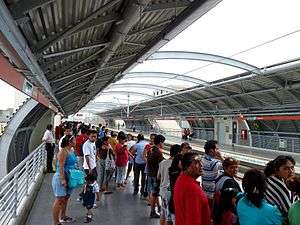
The central government decided in 2009 that the Ministry of Transport and Communications (MTC) retook the administration of the AATE (Electrical Train Autonomous Authority), putting a dependency called Provias Nacional in charge of organizing a public international licitation to select the consortium in charge of the civil works for the remaining section of the train and its electromechanical equipment. Financing would come from a foreign debt operation with the Development Bank of Latin America (CAF) for US$300 million. This credit was approved in August 18, 2009.
On December 2, 2009, the Ministry gave way for the construction to the "Consorcio Tren Eléctrico Lima" consortium, formed by Odebrecht (Brazil) and Graña y Montero (Peru). The project, according to contract, will be delivered in July 5, 2011, barely days before the second presidency of Alan García ends, thus justifying the need to work in six fronts simultaneously (Angamos, San Borja Sur, Javier Prado, Nicolás Arriola and Grau). Construction started On March 2, 2010 and, as of February 2011, the project is complete except for electrification and rebuilding of the current Italian trains.
In parallel, the Ministry of Transports and Communications (MTC) is organizing a new public contest with the Private Investment Promotion Agency (Proinversión) to select the train operator. Whoever wins the contest shall be provided with the remaining rolling stock, consisting of the acquisition of an additional 7 trains (48 cars) to complement what already exists.[6] The operator will also be in charge of operating the metro for 30 years. In the same way, the Ministry of Transports and Communications (MTC) will start another international public licitation process for the construction of the second phase of Line 1, connecting the Intermodal Grau station with the district of San Juan de Lurigancho, passing through Av. Próceres de la Independencia all the way to Bayóvar. This way, the northeast and south parts of the city will be connected through 34 km (21.1 mi) railway, completing the first line of the Lima Metro system, the elevated viaduct, at the time was the longest in the world.[7][8]
On December 23, 2010, president Alan Garcia established through supreme decree 059-2010-MTC[9] the Basic Metro Network of Lima and Callao, signaling the implementation of a network consisting of 5 lines of metro for Lima, contemplating the construction of ground, elevated and underground segments.[10]
On July 11, 2011 President Alan Garcia inaugurated Line 1 of the Lima Metro, in its second phase from Villa el Salvador to Downtown Lima.
On May 13, 2013, Ministry of Transport and Communications (MTC) said that the government also awarded concessions of lines 3 and 4 of the Lima Metro, by July 2016, of the five lines that have this public transport system.[11]
Line 1
The Lima Metro first phase has sixteen passenger stations, located at an average distance of 1.2 km (0.7 mi). It starts its path in the Industrial Park of Villa El Salvador, south of the city, continuing on to Av. Pachacútec in Villa María del Triunfo and then to Av. Los Héroes in San Juan de Miraflores. Afterwards, it continues through Av. Tomás Marsano in Surco to reach Ov. Los Cabitos and then on to Av. Aviación to finish in Av. Grau in the city center.
Currently, Line 1 has a fleet of trains from the 1980s by AnsaldoBreda, put in service through the 16 stations. This fleet includes an additional 42 trains in order to be able to service with the adequate frequencies, contemplating 26 stations in total, the integral remodeling of the current stations and the revamping of wagons, including the installation of air conditioning among other facilities and 19 new Alstom trains similar to the 9000 Series on the Barcelona Metro. Left-hand running is used on this line, unlike the other metro systems in South America (except Buenos Aires Metro).
Prior to July 2014, Line 1 was 21.48 kilometers (13.3 mi) long, operating from Villa El Salvador (where the maintenance depot is located) to the Miguel Grau station in Downtown Lima.
New lines
Line 2
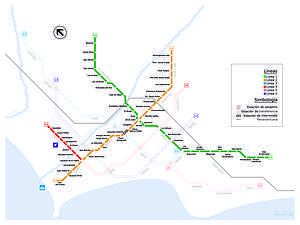
On February 15, 2012, at the conclusion of discussions between the Central Government and the Municipalities of Lima and Callao, President Ollanta Humala announced the upcoming construction of Metro Line 2 of Lima along the initially proposed route, with some variations, as a 27 km underground line, linking the district of Ate (Lima) and the Callao region adjoining the capital.
This line will interconnect with the current Line 1 station in Grau and the line no. 1 of the BRT in Central Station (which is also underground and currently in operation). Concurrently, the project include a first stage of line 4 this will connect the system to the International Airport and four stations beyond.
Transport Minister Carlos Paredes meanwhile projected that the underground work will take a maximum of six years. "We calculated that technical studies will take about two years and construction about three years. This means that the lines will begin operations in five or six years," said Paredes in 2012.[14]
An international consortium won the bidding for this project;[15] construction started in September 2014,[16] with the first section due to be operational in 2020, and the full line in 2024.[17]
Line 3
On March 21, 2012, Lima's mayor Susana Villaran presented a feasibility study of an underground metro line that follows in large parts the route of Line 3 as originally planned by the central government. The study was done in 2009 for the municipality of Lima, with support from the French government.
According to the mayor’s statements, these studies will be under consideration by the Ministry of Transport and Communication, and construction of this line will take only four years. The line will be underground from north to south, serving a section of the city with high ridership potential. This line is described as a "high speed" line, based on the distances between stations.
On May 13, 2013, the Ministry of Transport and Communications (MTC) said that the government had also awarded concessions for the construction of lines 3 and 4 by July 2016, out of the five lines that constitute the system.[18]
Line 4
On May 9, 2012, the director of the Private Investment Promotion Agency (Proinversión), Hector Rene Rodriguez, announced that the MTC (Ministry of Transport and Communication) would construct Lines 2 and 4 simultaneously. Line 4 will follow an east-west route connecting the district of La Molina with Jorge Chavez International Airport.
This line has a stage to be developed as a part of the concession of line 2, which is already under construction, is an 8 km section that will link line 2 with Jorge Chávez International Airport, this section should be operational in 2019.
On May 13, 2013, the Ministry of Transport and Communications (MTC) said that the government had also awarded concessions for the construction of lines 3 and 4 by July 2016, out of the five lines that constitute the system.[19]
Line 5
Metro Line 5 will connect the districts in the south of the city, like Miraflores, Barranco and Chorrillos; with a final station next to the south Panamerican highway Villa toll. By now it is planned but there is no studies of design nor construction yet.
Line 6
Metro Line 6 has been presented in 2014 as a private initiative and is under evaluation. These studies will determine technical aspects regarding whether Line 6 will be underground, aerial or both. The line has a length of 32 km extending, from the Naranjal Station of BRT system Metropolitano through Av. Tupac Amaru, Los Alisos Avenue, Universitaria Avenue, Bertolotto Avenue, Perez Aranibar Avenue, and Angamos-Primavera Avenue.
See also
- Transport in Lima
- El Metropolitano
- List of metro systems
- List of rapid transit systems
- List of Latin American rail transit systems
References
- "Línea 1 del Metro de Lima bate récord al movilizar 692 mil pasajeros en un solo día". www.andina.com.pe (in Spanish). December 25, 2019. Retrieved December 25, 2019.
- Informe Anual de la concesion pg13
- Linea 1 Archived April 14, 2015, at the Wayback Machine - Grupo Emepa
- Video of the "El Tren Eléctrico" song YouTube.com.
- "Este mes ProInversión definirá cronograma para concesión de operación del Tren Eléctrico". www.andina.com.pe (in Spanish). August 6, 2009. Retrieved January 13, 2012.
- "ProInversión incluye ruta Av. Grau - San Juan de Lurigancho en concesión para operar Tren Eléctrico". www.economia.terra.com.pe (in Spanish). April 8, 2010. Archived from the original on March 6, 2012. Retrieved January 13, 2012.
- "Archived copy". Archived from the original on January 11, 2014. Retrieved April 9, 2012.CS1 maint: archived copy as title (link)
- "Archived copy". Archived from the original on February 24, 2011. Retrieved February 9, 2011.CS1 maint: archived copy as title (link)
- "Gobierno aprueba Red Básica del Metro de Lima y Callao que cubre diversos distritos". www.andina.com.pe (in Spanish). December 24, 2010. Retrieved January 13, 2012.
- "MTC asegura que adjudicará líneas 3 y 4 del Metro de Lima antes de julio del 2016". www.andina.com.pe (in Spanish). May 13, 2013. Archived from the original on June 9, 2013. Retrieved May 13, 2013.
- "Lima metro opens Line 1 extension". Railway Gazette International. July 28, 2014. Retrieved August 4, 2014.
- "Línea 1". Metro de Lima. Retrieved August 4, 2014.
- http://elcomercio.pe/lima/1386895/noticia-primer-tramo-linea-metro-lima-operara-2016
- http://www.americaeconomia.com/negocios-industrias/peru-consorcio-nuevo-metro-de-lima-gana-licitacion-de-linea-2-por-us5364m
- http://elcomercio.pe/lima/transporte/fin-mes-empieza-construccion-linea-2-metro-noticia-1754277
- "Vizcarra promises that Lima metro's Line 2 will be done eight years earlier than planned". Peru Reports. December 13, 2018. Retrieved August 16, 2019.
- "MTC asegura que adjudicará líneas 3 y 4 del Metro de Lima antes de julio del 2016". www.andina.com.pe (in Spanish). May 13, 2013. Archived from the original on June 9, 2013. Retrieved May 13, 2013.
- "MTC asegura que adjudicará líneas 3 y 4 del Metro de Lima antes de julio del 2016". www.andina.com.pe (in Spanish). May 13, 2013. Archived from the original on June 9, 2013. Retrieved May 13, 2013.
External links
| Wikimedia Commons has media related to Lima Metro. |
- Línea 1 del Metro de Lima (in Spanish)
- Consorcio Metro de Lima (in Spanish)
- Autoridad Autónoma del Sistema Eléctrico de Transporte Masivo de Lima y Callao (AATE) (in Spanish)
- Agencia de Promoción de la Inversión Privada (in Spanish)
- Urban Rail - Lima Metro
